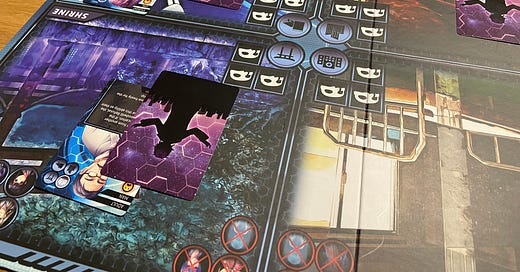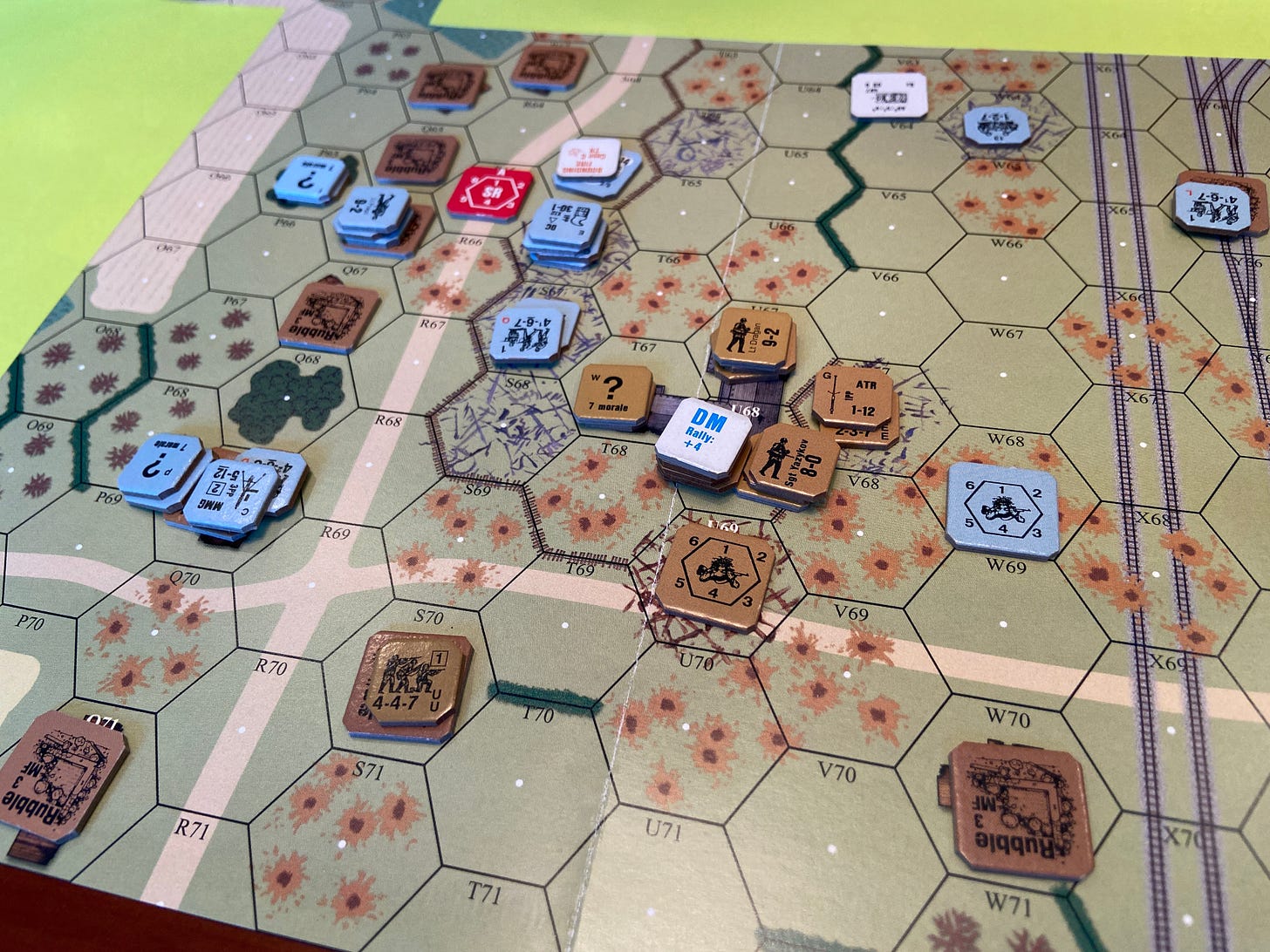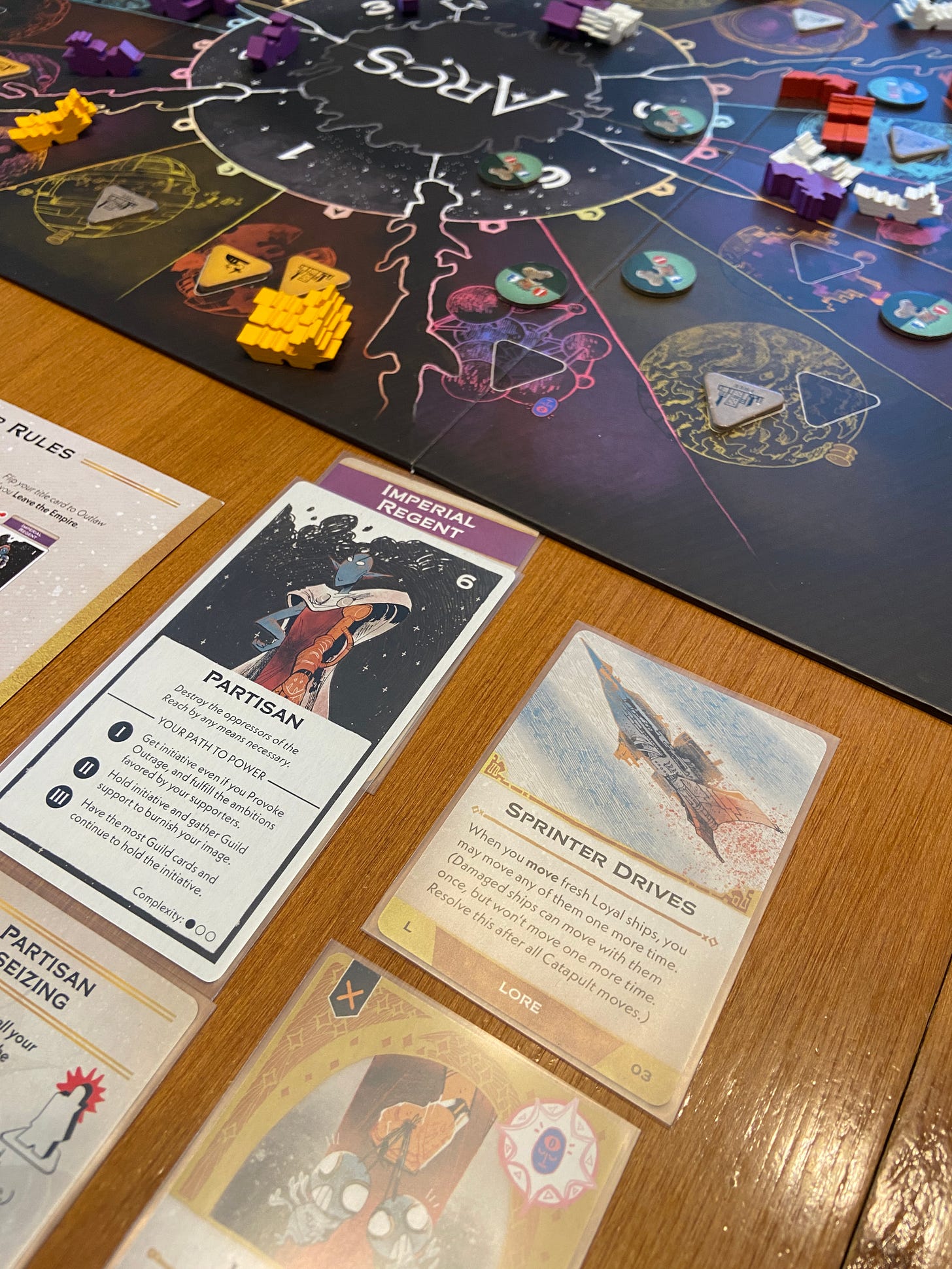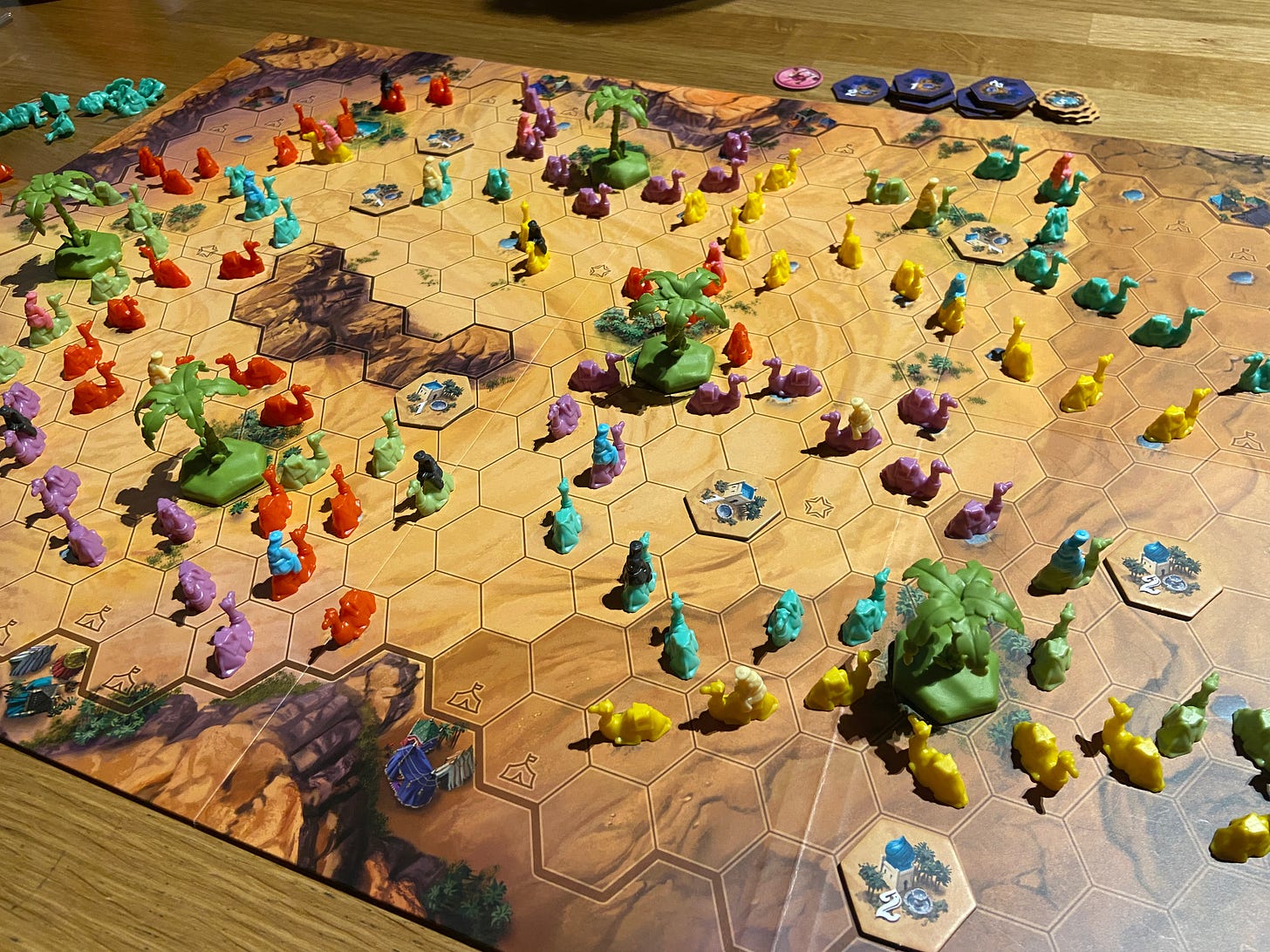Tragedy Looper, Arcs, Slaughter at Ponyri, Molly House, Through the Desert, Unstoppable
Week of May 5th, 2025
After a long absence due to orchestra rehearsals, I finally made it back to the Guildhouse Meetup group this week. I had somewhat randomly been talking about Tragedy Looper over the previous weekend, so when it came time to pick some games to drag to downtown San Jose I took a chance and grabbed my copy. This is a game I adore — not as an “every week” kind of a game, but as an outstanding niche game.
This is the 2023 WizKids edition, which I had not used before. While it loses some of the idiosyncratically Japanese flavor and does feel slightly low-budget, there are definitely major usability improvements. Font sizes are still too small because this is the hobby gaming industry apparently, but the contrast is much better and the board state is just a lot more readable. The real win is in the rules and the Mastermind booklet though. Tragedy Looper is not a complicated game, but in English it’s always been dogged by a not-great rulebook and the difficulty of playing the Mastermind the first couple times out. The new book gives the Mastermind much more orientation on how to play. For the first couple tragedies the structure is fully laid out with detailed instructions on what you need to do to win, with the first one even giving turn-by-turn instructions for the first couple days. It makes the game much easier to get into. I have played the game a bit, but not a ton and not in quite a while; I was playing the Mastermind and was very grateful to have the very specific guidance.
I haven’t done a detailed inventory of what has changed in the new edition, but: there are 2 extra tragedies and 12 new characters. Most of the new characters are from the original expansions. Some of the tragedies are from the original and have been tweaked, some are unchanged, and some are new (I haven’t done a detailed rundown of the differences since I haven’t played quite a few of the originals, but here is a more detailed comparison). While the new edition is overall better, the one definite fail is that the reference sheet is demonstrably worse. I’m thinking about making some copies of the original with the couple of small fixes that it needs. I also wish it had included a little more expansion content, given that it exists; the new edition contains the basic First Steps and Basic Tragedy structures from the original, which admittedly have a ton of play value, but it could have included some of the fun expansion plots (Prime Evil, Mystery Circle) for variety since it did include the characters. But with all those characters, the space for roll-your-own or fan-built plots is large.
Tragedy Looper really is a great game. Deduction games are hard. They’re often pretty dry, primarily demand developing a good note-taking scheme, and lack much replayability. Tragedy Looper addresses all these things. It’s got an evocative setting, colorful characters, and it’s built around a strong narrative sense. It’s equally engaging for the Protagonists and the Mastermind, although the Mastermind does require somewhat more expertise. The dizzying array of tragedy configurations makes it much more than just trying to figure out how to take notes, you need to observe and theorize and test. Because the tragedies are structurally complex and information is often incomplete, it provides lots of ways for the team of Protagonists to work together and discuss, plus the game works well with the full compliment of 4 players — somewhat unusual for this sort of game. Compared with my other favorite deduction game, The Alchemists, Tragedy Looper just gets a lot done very economically in terms of both complexity and playing time. And it’s nicely evocative as you go through time Quantum Leap-style trying to put things right.
I don’t know if Tragedy Looper is a hidden gem exactly, but it is a gem, and while the WizKids edition still has some flaws it’s far more approachable.
For ASL day we broke out the latest historical module, Slaughter at Ponyri. This is SaP9, Schoolhouse Rock. It was fine, but not great — it’s a slugfest, the Soviets just kinda hunker down in the central fortified building and hope. Reminded me a bit of some of the Manila scenarios. After the initial setup I don’t know how many significant decisions the Soviets are really making. It has a bunch of fun stuff though, including a pre-registered Katyusha strike, and the Germans have some significant challenges as there is not a ton of great cover in the approaches to the building.
Since this covers the battle of Kursk, it gives me an opportunity to air out my one huge grievance with ASL that I’m kind of horrified hasn’t been fixed in the almost 40 years it’s been around in various forms. The defending side in this scenario is not Russian. It’s Soviet. Using the term Russian to cover the entire Soviet army would be like calling all Commonwealth troops English. Yes, Russians comprised the majority of Soviet soldiers, but it was a bare majority, and the USSR was a huge, multi-ethnic conglomerate. Continuing to refer to the Soviets as Russians is obviously especially problematic in 2025; the second most important contributors to the Soviet Red Army by a wide margin (in terms of numbers) were Ukrainians. But soldiers came from all over the place: the Caucuses, central Asia, the far east, and indigenous cultures. This Russian whitewashing is egregious and needs to get fixed.
We started a new Arcs: The Blighted Reach campaign! It’s been a while since I did one. There has been a kind of shocking number of exceptionally high-quality big, multiplayer games in recent years: Arcs, Weimar, Hegemony, Conquest & Consequence, John Company 2nd, Sidereal Confluence, Oath, Triumph & Tragedy, the Dune reboot. It makes finding space for any individual game difficult. Obviously there are much worse problems to have, but for me anyway, it’s a legit problem! I wish I could play most of them more.
Anyway, Arcs is still great. The way to play the campaign that I’ve settled on is to do two sessions. First session starts Act 1 in the early-to-mid afternoon, then take a break and go out for dinner, and play Act 2 in the early evening. The first two Acts take “only” about 5 hours combined for us these days, but the dinner break really helps since it’s such an intense game. Then we can finish Act 3 later, in an afternoon. For us, scheduling three sessions in reasonably close proximity is harder than scheduling two with one of them being longer; plus Act 1 & 2 are short and doing both in one session is more satisfying. The full campaign is, to me, the most engaging way to play Arcs but finding the time definitely involves a bunch of trade-offs and you have to figure out what works for your group.
It had been a while since we played so people selected the more straightforward fates: Magnate, Founder, Partisan, and Advocate in the first act, with the Partisan and Founder departing after Act 1 and the Pacifist and Blight Speaker joining. On the one hand this was nice because the game was not super-complicated (by Arcs standards) and we could breeze through it; but on the other hand the more exotic fates (Believer, Caretaker, Hegemon, Planet Breaker, Gate Wraith) do add a ton of color to the game.
Just due to the time commitment and difficulty of scheduling, this did remind me that the regular, non-campaign version of this works well for a standard game night, and once you include Leaders & Lore it does have a good amount of the flavor of the campaign without the large time commitment. When I break this out I tend to want to play the campaign, but that’s a bit myopic.
Molly House got its debut at the Guildhouse group. Yeah, sadly the wooden pawns are much more functional and even more aesthetic than the deluxe metal ones. I was now comfortable enough with the game to do a solid teaching job in a reasonable amount of time, and folks seemed to quite enjoy the game. We played with 3, which works well although I would say the game is better with 4 (I haven’t played with 5 yet). I think the hardest thing is teaching the alternate victory condition for community infiltration and how you can get rid of indictments if you become an informer. You could explain it at the jump, but players’ eyes will glaze over as they’re having a hard enough time understanding the implications of the Festivities and Reputation, and becoming an informer is a bridge too far to deal with for almost everyone (certainly everyone I’ve played with), and nobody will remember by the time it becomes relevant. So I think you need to do it at the end of the 2nd turn. It would make no sense to make the decision to pivot to informer before then anyway.
This is enough of an unusual game that I am not totally confident in introducing it to people I don’t know that well. But like Arcs, so far it has exceeded my expectations and gone over very well with everyone.
Like all of Cole’s and Wehrlegig’s games (so far), this rewards investment and repeat play. I think probably for most people, the game will really start to sing around game 3. This obviously isn’t a feature in today’s gaming environment, although perhaps the game will benefit from tariffs strangling new game releases for a while — here in the US anyway. While the tariffs are unambiguously bad in that they’re capricious, punitive and indiscriminate, not going to deliver on their stated goals, and are going to arbitrarily hammer both good and bad games, there is probably a slight silver lining in that a slowdown in the flood of new releases might give some excellent games a chance to breathe. We definitely need a general culling and a focus on quality in the marketplace; this is not going to do that directly, unfortunately, but it might be a minor and very indirect nudge in the right direction.
Speaking of endlessly replayable classics, Through the Desert hit the table as the closer at the Guildhouse. I love the AllPlay edition of this despite the loss of the iconic pastel camels: the compact box, the clear colors, the nice art, the multiple variants. This is not going to be for everyone, as it can get (in the words of one of our players) “spicy”. But it only takes a couple minutes to teach, it’s throughly interesting, and the constant tension can create fun lighthearted table banter with the right group. This is one of those games that has been emulated but never bettered and is a nearly perfect game for what it’s trying to do. Give me this over Ticket to Ride or Carcassonne every day of the week (and twice on Sunday).
After a little bit of a break we’re back on the Unstoppable train. I’ve played a few times solo and we’ve done a couple 2-player cooperative games. The different bosses have turned out to be slightly disappointing; they’re not bad, but we usually just play the Harbinger now. I can now definitely say it’s a solo game with a multiplayer bolt-on (unsurprisingly), but there is more to the 2-player game than usual and I’ve enjoyed it. The reason I say it’s a solo game is just that it feels more random than John D Clair’s games usually are. Drafting from 3 cards at a time, Slay the Spire style, is just a lot of variance. Sometimes you just get nothing in the critical early game. I feel that’s fine in a solo game where the challenge is often just to do the best that you can, but 2-player wants a bit more balance generally. Bottom line though is, as I say, that we have totally enjoyed it. The pressure to keep moving until you collapse over the finish line (hopefully), combined with the amount of flexibility the game gives you and the huge range of cards and upgrades, it’s just very compelling.
Our local FLGS hosts a flea market which I used to do somewhat regularly pre-pandemic. I stopped because of a combination of having fewer games to sell, significantly decreased foot traffic because for a while they decided to hold them a lot more frequently than there was demand for, and the general cratering of the secondary market value of boardgames. I had accumulated enough stuff though and have really been trying to aggressively reduce the collection, so I thought I’d try it again. Results were disappointing, albeit not awful; about 15 games sold, mostly more recent stuff so the take was ok. But I found myself considering for the first time that some significant number of these are going to end up in landfill. As recently as 10 years ago this was never something that even occurred to me. I could always go to a flea market and price things to move and get more or less cleaned out. It seemed that used games would always sell, it was just a matter of pricing them low enough. I have been well aware that the secondary market for games has been softening significantly for a while, but now I have to accept the fact that the used market isn’t just soft, there is basically no market for a lot of mid-tier games or games more than a few years old. It’s sobering. For a long time I’ve been preaching that the escalating environmental crisis doesn’t mean we have to give up a hobby we love, but it does mean we have to be smarter than we’re currently being. This definitely recalibrates how I view that. What number of plays do you have to get out of a game for it to have been a responsible purchase? More than 5, presumably. 10? 20? How large can your “shelf of shame” be before it becomes an ethical issue? Under capitalism as currently configured, the only check on destructive runaway consumerism is our individual commitment to not doing it. I hope I can do a better job in future.
Coda
I think I’ve mentioned that I haven’t really found a ton of long-form music for symphonic winds that I’ve liked, but I heard this symphony played by the Stanford Wind Symphony recently and it really blew me away. Look, like all these works, live is the way to hear it. No recording is going to come anywhere close to replicating hearing a large classical ensemble (orchestra or symphonic winds) in a decent hall — even with lossless compression and high-quality noise-cancelling headphones — and it’s probably particularly true in this case. These ensembles have a physical presence that cannot even be approximated. But that said, this is wonderful piece. It is on par with the British masters (Holst, Grainger, Vaughn Williams) in terms of skillful use of the wide range of tone colors in a wind ensemble. There are only a couple contemporary composers (Sparke, Tichelli) and I’m not sure I would even say their orchestration is this interesting — this symphony is a fascinating application of an orchestral style to a wind ensemble instrumentation. There is great writing for all the sections including underutilized ones like the bassoons and saxophones and of course my beloved bass clarinet. The tuba gets a great melodic line. Plus it has a great musical narrative sense, something not always true about contemporary composers. There is something really special for me about discovering new music I love and that changes how I think as an older adult.
That’s it! See you next week!
If you’re enjoying these newsletters, please remember to like and subscribe and also to forward to friends who might be interested. We’re still growing and if you think this content is valuable, helping with discovery helps everyone.










